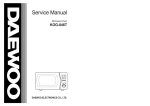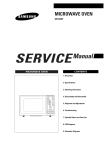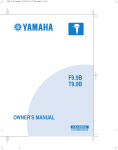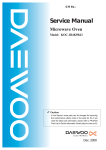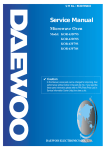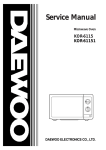Download Daewoo KOG-846T Service manual
Transcript
Service Manual Microwave Oven KOG-8465 ✔ Caution : In this Manual, some parts can be changed for improving, their performance without notice in the parts list. So, if you need the latest parts information,please refer to PPL(Parts Price List) in Service Information Center (http://svc.dwe.co.kr). Power 1 2 3 6 4 40 50 6 0 0 30 Timer 5 7 8 9 10 20 DAEWOO ELECTRONICS CO., LTD. PRECAUTIONS TO BE OBSERVED BEFORE AND DURING SERVICING TO AVOID POSSIBLE EXPOSURE TO EXCESSIVE MICROWAVE ENERGY (a) Do not operate or allow the oven to be operated with the door open. (b) Make the following safety checks on all ovens to be serviced before activating the magnetron or other microwave source, and make repairs as necessary: (1) Interlock operation, (2) proper door closing, (3) seal and sealing surfaces (arcing, wear, and other damage), (4) damage to or loosening of hinges and latches, (5) evidence of dropping or abuse. (c) Before turning on microwave power for any service test or inspection within the microwave generating compartments, check the magnetron, wave guide or transmission line, and cavity for proper alignment, integrity, and connections. (d) Any defective or misadjusted components in the interlock, monitor, door seal and microwave generation and transmission systems shall be repaired, replaced, or adjusted by procedures described in this manual before the oven is released to the owner. (e) A microwave leakage check to verify compliance with the Federal performance standard should be performed on each oven prior to release to the owner. TABLE OF CONTENTS PROPER USE AND SERVICE PRECAUTIONS SPECIFICATIONS EXTERNAL VIEWS NAMES AND FUNCTION OF PARTS CONTROL PANEL HOW TO SET THE OVEN CONTROLS INTERLOCK MECHANISM FUNCTIONS AND ADJUSTMENTS PRECAUTIONS FOR DISASSEMBLY AND REPAIR DISASSEMBLY AND ASSEMBLY TROUBLE SHOOTING GUIDE MEASUREMENT COMPONENT TEST PROCEDURE WIRING DIAGRAM SCHEMATIC DIAGRAM WIRING DIAGRAM(GERMANY) SCHEMATIC DIAGRAM(GERMANY) EXPLODED VIEW 2 3 5 5 6 7 8 11 13 14 21 25 27 28 29 31 32 34 PROPER USE AND SERVICE PRECAUTIONS CAUTION : This Device is to be Serviced Only by Properly Qualified Service Personnel. Consult the Service Manual for Proper Service Procedures to Assure Continued Safety Operation and for Precautions to be Taken to Avoid Possible Exposure to Excessive Microwave Energy. 1. For Safe Operation Damage that allows the microwave energy (that cooks or heats the food) to escape will result in poor cooking and may cause serious bodily injury to the operator. IF ANY OF THE FOLLOWING CONDITIONS EXIST, OPERATOR MUST NOT USE THE APPLIANCE. (Only a trained service personnel should make repairs.) 1) 2) 3) 4) 5) A broken door hinge. A broken door viewing screen. A broken front panel, oven cavity. A loosened door lock. A broken door lock. The door gasket plate and oven cavity surface must be kept clean. No grease, soil or spatter should be allowed to build up on these surfaces or inside the oven. DO NOT ATTEMPT TO OPERATE THIS APPLIANCE WITH THE DOOR OPEN. The microwave oven has concealed switches to make sure the power is turned off when the door is opened. Do not attempt to defeat them. DO NOT ATTEMPT TO SERVICE THIS APPLIANCE UNTIL YOU HAVE READ THIS SERVICE MANUAL. 2. Correct Installation 1) This microwave oven weighs 18 kg(40lbs.) and must be placed on a horizontal base strong enough to support this weight. 2) The oven should be placed as far from high temperature source and vapour as possible. 3) The power supply cord is about 1.6m (5.25ft) long. Earthing is required when connecting the power source. 4) Power consumption of this oven is approximately 2.8 kw. It is suggested that the unit is operated on such power line(about 12 amperes) that can provide more power than this rating. 5) Object must not be placed on the top enclosure so as not to obstruct air flow for ventilation. CAUTION MICROWAVE RADIATION PERSONNEL SHOULD NOT BE EXPOSED TO THE MICROWAVE ENERGY WHICH MAY RADIATE FROM THE MAGNETRON OR OTHER MICROWAVE GENERATING DEVICE IF IT IS IMPROPERLY USED OR CONNECTED. ALL INPUT AND OUTPUT MICROWAVE CONNECTIONS, WAVEGUIDE, FLANGES AND GASKETS MUST BE SECURE. NEVER OPERATE THE DEVICE WITHOUT A MICROWAVE ENERGY ABSORBING LOAD ATTACHED. NEVER LOOK INTO AN OPEN WAVEGUIDE OR ANTENNA WHILE THE DEVICE IS ENERGIZED 3 IMPORTANT The wires in this mains lead coloured in accordance with the following code. Green-and-yellow : Earth Blue : Neutral Brown : Live As the colours of the wires in the mains lead of this appliance may not correspond with the coloured markings identifying the terminals in your plug, proceed as follows: The wire which is coloured green-and-yellow must be connected to the terminal in the plug which is marked with the letter ‘E’ or by earth symbol or green-and-yellow. The wire which is coloured blue must be connected to the terminal which is marked with the letter ‘N’ or coloured black. The wire which is coloured brown must be connected to the terminal which is marked with the letter ‘L’ or coloured red. NOTE : This oven is designed for counter-top use only. 4 SPECIFICATIONS Power Supply 230V~, 50Hz 240V~, 50Hz(U.K) Power Consumption 1,450 W 1,500W Output Power 900W (IEC 705) 900W (IEC 705) Frequency 2,450 MHz 2,450 MHz Grill power consumption 1,400 W 1,500W Simultaneous Heating Power Consumption 2,800 W 2,950 W Outside Dimensions (W X H X D) 501 X 319 X 389 mm (19.7 X 12.6 X 15.3 in.) Cavity Dimensions (W X H X D) 310 X 229 X 330 mm (12.2 X 9.0X 13.0 in.) Net Weight Approx. 18 kg (40 Ibs.) Timer 60 min. Dual Select Function Microwave/Grill/Simultaneous Heating Microwave Power Level High/Med High/Med/Defrost/Low Microwave (900W) (725W) (520W) (310W) (165W) Simultaneous heating Level 3-Levles( Grill+M/W 3-Power levels) * Specifications subject to change without notice. EXTERNAL VIEWS 5 NAMES AND FUNCTION OF PARTS ¤ DOOR SEAL Door seal maintains the microwave within the oven cavity and prevents microwave leakage. ¤ CONTROL PANEL ¤ GLASS TURN -TABLE TRAY Rotates during cooking and ensure even distribution of Microwaves. It can also be used as a cooking utensil. ¤Ł DOOR HOOK When door is closed, it will autoamtically lock shut. If door is opened while oven is operating, magnetron tube will immediately stop operating. ¤ OVEN FRONT PLATE ¤ ROLLER GUIDE This must be always used for cooking together with the glass turn-table tray. Use a mild detergent, water and a soft cloth to clean the roller guide. ¤Ø DOOR SCREEN Allows viewing of food. Microwave cannot pass through perforations in screen. ¤Œ GRILL HEATER Turns on when grill and simultaneous cooking is selected. ¤æ COUPLER This fits over the shaft in the center of the oven’s cavity floor. This is to remain in the oven for all cooking. ¤º OVEN LAMP Automatically turns on during oven operating. ¤ SAFETY INTERLOCK SYSTEM 6 CONTROL PANEL POWER OR FUNCTION SELECT KNOB - Used to select a microwave power level in M/W, GRILL or SIMUL. cooking. Power - Used to select a function before the cooking. 1) M/W oven-used to heat food with microwave. 2) GRILL-Used to browning food with grill heater. 3) SIMUL. - used to simultaneous cooking with microwave and grill heater. 0 1 2 3 40 50 6 0 Timer 4 - Used in setting cooking time for all functions. 6 30 5 TIMER KNOB 7 8 NOTE : When setting TIMER for less than 1 minute, turn the TIMER past 1 minute and then return to correct timing. 7 9 10 20 HOW TO SET THE OVEN CONTROLS NOTE : ¡ Be sure to read the cookbook’s introduction before operating the oven. ¡ Also remember to read this operating instruction for proper safety information and instruction before using the oven. ¡ See the cookbook for specific recipes. ¡ Prior to setting the controls, place one cup of water in the oven, in a heat-proof glass measuring cup, for testing purposes. ¡ You may open the door while the oven is operating. ¡ As soon as the door is opened, the safety mechanisms stop power. ¡ To continue cooking, close door, then the oven is operated. ¡ If you wish to change the time during cooking, simply adjust the TIMER to desired minutes. ¡ When time has elapsed, a bell will ring and the oven will turn off. 1. MICROWAVE DEFROST • This oven has 5-power levels in microwave cooking. • You can select these levels by POWER knob. 1. place food inside oven. 2. Set POWER knob to appropriate M/W power level position. 3. Set TIMER knob to the cooking time. SYMBOL M/W POWER LEVEL OUTPUT POWER LOW 165W DEFROST 310W MEDIUM 520W MED. HIGH 725W HIGH 900W NOTE : Output power refer to a value of reference. 8 2. GRILL COOKING ¥ Grilling in this oven is similar to conventional broiling. ¥ There is no need to preheat the oven for griling. 1. Place food on the Metal Rack, and set it on the Tray. 2. Set POWER knob to GRILL position. 3. Set TIMER knob to the cooking time. EXAMPLE : To Grill hamburgers, steaks, kabobs, etc. use the trays this way: To use : • Place food on Metal Rack. • Place the Metal Rack directly on the Turntable. 9 2. COMBINATION COOKING ¥ This oven has 3-cooking levels in SIMUL-COOKING. ¥ You can select these levels by POWER knob. (COMBI 1) Grill + M/W Low (COMBI 2) Grill + M/W Med Low (COMBI 3) Grill + M/W Med 1. Place food on the Metal Rack or Tray. 2. Set POWER knob to SIMUL position. 3. Set TIMER knob to the cooking time. • To prevent the oven operating with the door open, this oven is fitted with safety door interlock switches. If you wish to inspect the food during the cooking time, simply open the door. The oven will automatically stop the cooking. • To continue cooking, close the door. • If you wish to stop the cook during the cooking, simply turn the timer knob to the point “OFF”. Cooking time can be reset at any time during cycle by turing the timer knob. • Do not let the timer continue to oeprate after removing food. 10 INTERLOCK MECHANISM FUNCTIONS AND ADJUSTMENTS The door lock mechanism is a device which has been specially designed to completely eliminate micreowave radiation when the door is opened during operation, and thus to perfectly prevent the danger resulting from the leakage of microwave. (1) Primary interlock switch When the door is closed, the hook will lock the oven door. If the door is not closed properly, the oven will not operate. When the door is closed, the hook pushes the lever downward. The lever presses the button of the primary interlock switch to bring it under ‘ON’ condition. Adjustment 1 When the door is closed, the switch button is pushed by the hook. The movement of the switch button should exceed 1.2 mm measured at the top of the button. 11 (2) Secondary interlock switch, monitor interlock switch When the door is closed, the hook pushes the lever lock forward, and the lever presses the button of the interlock monitor switch to bring it under ‘OFF’ condition. Simultaneously, the lever lock presses the button on the secondary interlock switch to bring it under ‘ON’ condition. Monitor interlock s/w Lever hook Door open monitor s/w Hook Lever lock Spring hook lever Adjustment 2 Interlock monitor switch When the door is closed, the monitor switch should be opened before other switches closed. When the door is opened, the monitor switch should be closed after other switches opened. Secondary interlock switch The movement of the switch button should exceed 1.2mm measured at the top of the button. Adjustment step: a) Loosen the two mounting screws. b) Adjust the interlock switch assembly position. c) Confirm the gap(1.2mm) described above. d) Make sure that the latch lever moves smoothly after adjustment is completed e) Completely tighten the two mounting screws. 12 PRECAUTIONS FOR DISASSEMBLY AND REPAIR - Cautions to be observed when trouble shooting. Unlike many other appliances, the microwave oven is high-voltage, high-current equipment. It is completely safe during normal operation. However, carelessness in servicing the oven can result in an electric shock or possible danger from a short circuit. You are asked to observe the following precautions carefully. (1) Always remove the power plug from the outlet before servicing. (2) use an insulated screwdriver and wear rubber gloves when servicing the high voltage side. (3) Warning about the electric charge in the high voltage capacitor. When inspecting and repairing the high voltage side, always short the capacitor terminals and make sure of discharge. 1. Check the earthing. Do not operate on a 2-wire extension cord. The microwave oven is designed to be used when earthed. It is imperative, therefore, to makes sure it is earthed properly before begining repair work. 2. Warning about the electric charge in the high voltage capacitor. (Refer to Fig. 1) For about 30 seconds after the operation stops, electric charge remains in the high voltage capacitor. When replacing or checking parts, short between oven chassis and the negative high terminal of the high voltage capacitor, by using a properly insulated screw driver to discharge. Fig.1 (4) When the fuse(normal blow type) is blown out due to the operation of the monitor switch; replace primary, secondary interlock switch and monitor switch. Refer 11~12 page for the necessary adjustment. (5) After repair or replacement of parts, make sure that the screws are properly tightened and all electrical connections are tightened. (6) Do not operate without cabinet. CAUTION : Service personnel should remove their watches whenever working close to or repairing the magnetron. WARNING: When servicing the appliance, care is required when touching or replacing high potential parts due to electrical shock or exposure of microwave energy. These parts are as follows-H.V. transformer, Magnetron, H.V. Capacitor, H.V. Diode. 13 DISASSEMBLY AND ASSEMBLY 1. To remove cabinet (Refer to Fig. 2) 1) Remove four screws on cabinet back. 2) Push the cabinet backward. Fig. 2 2. To remove parts of guide wind assembly (Refer to Fig.3) 1) Release the earth screw F57 . 2) Remove the noise-filter F52 to the guide wind F42 . 3) Pull the fan F45 to the motor shaft. 4) Release two screws F44 which secure the motor shaded pole F43 . 5) Remove the motor shaded pole. 6) Release a screw F48 which secure the holder capacitor F47 . 7) Remove the holder capacitor and capacitor F46 to the guide wind. 8) Remove the diode H.V F49 . 9) Reverse the above steps for reassembly. F53 F57 F52 F44 F42 F45 F43 F49 F46 F48 F47 Fig. 3 14 3. To remove lamp. (Refer to Fig. 4) F37 1) Remove a screw F37 holding lamp F36 to the guide air F34 . 2) Remove the lamp. 3) Reverse the above steps for reassembly. F36 F34 Fig. 4 4. To remove H.V. Transformer (Refer to Fig. 5) F21 1) Remove four screws F22 which secure the H.V. Transformer bracket to the base plate. 2) Remove the H.V. Transformer F21 . F22 Fig. 5 HIgh voltage circuit wiring H.V. Capacitor Magnetron H.V. Diode H.V. Trans 15 H.V. Fuse 5. To remove magnetron and magnetron thermostat. (Refer to Fig. 6) 1) Remove two screws F26 which secure the thermostat F25. 2) Remove the thermostat. 3) Remove three screws F24 which secure the magnetron F23 . 4) Remove the magnetron. 5) Reverse the above steps for reassembly. F26 F25 F23 F24 Fig. 6 CAUTION : Never install the magnetron without the metallic gasket plate which is packed with each magnetron to prevent microwave leakage. Whenever repair work is carried out on magnetron, check the microwave leakage. It shall not exceed 4mW/cm2 for a fully assembled oven with door normally closed. Metallic gasket plate Magnetron antenna Wave guide Cooling fin Magnetron Metallic gasket plate Filament terminal 16 magnetron antenna ✔ Caution: In this Service Manual, some parts can be changed for improving, their performance without notice in the parts list. So, if you need the latest parts information, please refer to PPL(Parts Price List) in Service information Center(http://svc.dwe.co.kr) 6. To remove parts of control panel assembly (Refer to Fig. 7.8) 1) Remove a screw holding control panel assembly to the oven front plate. At the same time, draw forward the control panel assembly from oven front plate. 2) Remove two screws B11 which secure the timer assembly B10 . 3) Remove the timer assmebly B10 . 4) Pull out the knob B3 from the timer assembly B10 . 5) Pull out the coupler timer B9 from the timer assembly B10 . 6) Remove a screw B13 which secure the sw MICRO B12 . 7) Pull out the sw MICRO B12 from the control panel B1 . 8) Remove a screw B8 which secure the coupler VPC knob B7 . 9) Pull out the coupler VPC knob B7 and knob VPC B2 from the control panel B1 . 10) Remove the spring flat B6 . 11) Remove a screw B5 which secure the sw MICRO B4 . 12) Pull out the sw MICRO B4 from the control panel B1 . 13) Reverse the above steps for reassembly. Fig. 7 B5 B8 B6 B10 B4 B1 B11 B13 B9 B2 B12 B3 CONTROL PANEL AS : 3516710620 REF.NO. B1 B2 B3 B4 B5 B6 B7 B8 B9 B10 B11 B12 B13 PART CODE 3516705830 3513403900 3513401220 4415A66600 7121301611 3515101600 3517401200 7S312X40A1 3517401100 3518204900 7S341W40B1 4415A17352 7121301611 PART NAME CONTROL-PANEL KNOB VPC KNOB SW MICRO SCREW TAPPING SPRING FLAT COUPLER VPC KNOB SCREW SPECIAL COUPLER TIMER TIMER SCREW SPECIAL SW MICRO SCREW TAPPING DESCRIPTION Q’TY ABS 1 ABS 1 ABS 1 VP-532A-OF SPNC #187 1 T2S PAN 3X16 MFZN 1 SUS-301 T0.5 1 POM 1 T1 TRS 4X10 SE MFZN 1 POM 1 KN60MKD11E-P 1 T2S PAN 4X12 PW SE MFZN 2 VP-533A-OF SPNO #187 1 T2S PAN 3X16 MFZN 1 17 Fig. 8 REMARK ✔ Caution: In this Service Manual, some parts can be changed for improving, their performance without notice in the parts list. So, if you need the latest parts information, please refer to PPL(Parts Price List) in Service information Center(http://svc.dwe.co.kr) 7. To remove door assembly (Refer to Fig. 9) F20 1) Remove two bolts F19 and two nuts F20 which secure to hinge. 2) Remove door assembly A00 . 3) Remove door above for reassembly taking case to replace fixing glue. A00 8. To remove door parts. (Refer to Fig. 10) 1) Remove the frame door A9 and barrier-screen 2) Remove the absorber microwave A7 . 3) Pull the two fixture hook A5 . 4) Remove the spring hook A6 . 5) Remove two hooks A3 , and lever hook A4 . A8 . F19 Fig.9 DOOR AS : 3511704420 REF.NO. A1 A2 A3 A4 A5 A6 A7 A8 A9 PART CODE 3511704600 3517001800 3513100600 4413A44001 4413A40052 441G448071 3510100300 3517003600 3512203000 PART NAME DOOR PAINTING AS BARRIER-SCREEN *I HOOK LEVER HOOK AS FIXTURE HOOK SPRING HOOK ABSORBER MICROWAVE BARRIER-SCREEN *O FRAME DOOR 18 DESCRIPTION Q’TY 1 TEMPERED GLASS 3.2T 1 POM 2 KOR-640 1 SWRM3 Ø5.5XL12.5 2 SWPA80 1 PAI+FERRITE 1 GLASS 3.0T 1 ABS 1 Fig. 10 REMARK 9. Method to reduce the gap between the door seal and the oven front surface. (1) To reduce gap located on part ‘A’. 1) Loosen a Hex Bolt on top door hinge, then push the door to contact the door seal to oven front surface. 2) Tighten a Hex Bolt. (2) To reduce gap located on part ‘B’. 1) Loosen a Hex Bolt on bottom hingle, then push the door to contact the door seal to oven front surface. 2) Tighten a Hex Bolt. (3) To reduce gap located on part ‘C’ 1) Remove the cabinet. 2) Loosen a screw on interlock switch assembly located bottom of oven body. 3) Draw the interlock switch assembly inward as possible to engage with hook on the door bottom. 4) Tighten a screw. (4) To reduce gap located on part ‘D’. 1) Remove the cabinet. 2) Loosen a screw on interlock switch assembly located top of oven body. 3) and (4) are same as step (3). Door hook (under) Interlock monitor switch Mounting screw (Top) Door hook (upper) Primary interlock switch Mounting screw (bottom) NOTE : Small gap may be acceptable if the microwave leakage does not exceed 1mW/cm2. NOTE : The door on a microwave oven is designed to act as an electronic seal preventing the leakage of microwave energy from the oven cavity during the cook cycle, This function does not require that the door be air-tight, moisture (condensation) - tight or light-tight. Therefore, the occasional appearance of moisture, light or the sensing of gentle warm air movement around the oven door is not abnormal and do not of themselves, indicate a leakage of microwave energy from the oven cavity. If such were the case, your oven could not be equipped with a vent, the very purpose of which is to exhaust the vaporladen air from the oven cavity. 19 10. To remove tray motor. (Refer to Fig. 11) 1) Cut the tray motor cover parts from the base plate (Refer to Fig 11, 12). 2) Remove the tray motor cover. 3) Remove two screws F12 which secure the tray motor F11 to tray motor bracket. 4) Remove the tray motor. F11 F12 Fig. 11 (Front) (Bottom) Slit Nipper File Fig. 12 20 11. To remove grill heater assembly (Refer to Fig. 13) 1) Release three hex nuts F10 holding the Grill Heater Assembly 2) Remove Grill heater Assembly. F9 to top and side plate. F10 F9 Fig. 13 TROUBLE SHOOTING GUIDE Following the procedure below to check if the oven is defective or not. 1. 2. 3. 4. Check earthing before fault finding. Be careful of the high voltage circuit. Discharge the high voltage capacitor. When checking the continuity of the switches, fuse or high voltage transformer, disconnect one lead wire from these parts and check continuity with the AC plug removed. To do otherwise may result in a false reading or damage to your meter. NOTE : When electric parts are checked or replaced, be sure the power cord is not inserted the wall outlet. Check wire harness, wiring, and connection of the terminals, and power cord before check the parts listed below. 21 (TROUBLE 1) Oven does not operate at all; any inputs can not be accepted Condition Check Result Cause Fuse blows Check continuity of interlock monitor switch with door closed (COM¡ŒNC) (COM¡ŒNC) Malfunction of interlock monitor switch Replace Check continuity of both primary and secondary interlock switch with door closed No Continuity Malfunction of interlock switch Replace Shorted contacts of primary interlock switch Replace Check continuity of primary interlock switch contact with door partially open until interlock monitor switch contact close (COM¡ŒNC close) Outlet has proper voltage. Fuse does not blow Continuity (COM¡ŒNC) Remedy Note 1. No Continuity Note 1. Continuity Continuity Note 1. Check continuity both magnetron and heater thermostat No Continuity Defective magnetron and heater thermostat Replace check continuity of noise filter board No Continuity Defective line filter board Replace Check continuity of power supply cord No Continuity Open power supply cord Replace NOTE 1 : All these switches must be replaced at the same time, please refer to page 11 and 12 for adjustment instructions. 22 (TROUBEL 2) Heater does not heat (Food will not become hot). Condition Check Result Grill heater does not heat Check continuity of primary interlock switch No Continuty Malfunction of primary interlock switch Check continuity of heater select switch and timer switch No Continuity Defective timer ass’y Check continuity of heater thermostat No Continuity Chech continuity of secondary interlock switch No continuity Check continuity of heater No continuity 23 Cause Remedy Adjust or replace Replace the timer ass’y Defective heater thermostat Replace the heater thermostat Malfunction of secondary interlock switch Adjust or replace Defective heater Replace the heater (TROUBLE 3) No microwave oscillation even though fan motor rotates. Condition Fuse blows No microwave oscillation Check Check continuity of high voltage fuse Result (COM¡ŒNC) Cause Remedy No Continuity Replace high voltage fuse Check continuity of high voltage capacitor terminals with wires removed Continuity Defective high voltage transformer Replace Check continuity of high voltage recitifier in forword and backward direction with DC megger Continuity in backward direction Defective high voltage rectifier Replace Connect megger leads to magnetron terminal and magnetron body Continuity Defective magnetron Replace Check resistance of primary and secondary coil of high voltage transformer 0 Ω or ∞ Defective high voltage transfromer Replace Check continuity of magnetron heater with wires removed No Continuity Check continuity of filament terminal of high voltage transformer No Continuity Defective high voltage transfromer Replace No Continuity Defective timer ass’y Replace Check continuity of microwave select switch 24 Defective magnetron Replace MEASUREMENT 1. Microwave Output Power CAUTION : 1-1. Standard Method Microwave output power can be checked by indirectly measuring the temperature rise of a certain amount of water exposed to the microwave as directed below. 1) Microwave power output measurement is made with the microwave oven supplied at rated voltage and operated at its maximum microwave power setting with a load of 1,000¡ 5cc of potable water. 2) The water is contained in a cylindrical borosilicate glass vessel having a maximum material thickness of 3 mm and an outside diameter of approximately 190 mm. 3) The oven and the empty vessel are at ambient temperature prior to the start of the test. The initial temperature of the water is 10¡ 2¡£ c (50¡ 3.6¡£ F). It is measured immediately before the water is added to the vessel. After addition of the water to the vessel, the load is immediately placed on the center of the shelf which is in the lowest normal position. (Fig. 14). 4) Microwave power is switched on. 5) Heating time should be exactly 47 seconds. Heating time is measured while the microwave generator is operating at full power. The filament heat-up time magnetrons is not included. 6) The initial and final water temperatures are selected so that the maximum difference between the ambient and final water temperatures is 5K. 7) The microwave power output P in watts is calculated from the following formula: P=4187 ¡¿∆T/t 1. Water load should be measured exactly to 1 litre. 2. Input power voltage should be exactly volts as specified. 3. Ambient temperature should be 20¡ 2¡£ C 2. Electrical Continuity Check of Interlock Switch 2-1. Procedure NOTE : Remove the power plug from the wall receptacle before testing. 1. Primary Interlock Switch 1) Disconnect two connectors from Primary Interlock Switch. 2) Connect the ohmmeter leads between the terminals of the primary interlock switch. 3) Read the value of resistance between the terminals of the switch, when the door is opened, and when the door is closed. 2. Secondary Interlock Switch 1) Disconnect two connectors from secondary interlock switch. 2) Connect the ohmmeter leads between the terminals of the secondary interlock switch. 3) Read the value of resistance between the terminals of the switch, when the door is opened, and when then oven door is closed. • ∆T is actual temeprature rise. • t is the heating time. The power measured should be 900W¡ 10 %. 3. Interlock Monitor Switch 1) Disconnect the lead wire connecting the primary interlock switch and interlock monitor switch from primary interlock switch terminal. 2) Connect the ohmmeter leads between the lead wire connector disconnected as item ‘1’ and the power supply neutral plug pin. 3) Read the value of resistance between the lead wire connector and the power supply neutral plug pin, when the oven door is opened, and when the oven door is closed. Fig.14 25 2-2 Judgement The value of resistance should be applied to the value specified below. ∞ ∞ 0 0 0 ∞ When value obtained is not acceptable, the switch should be replaced or adjusted again. NOTE : 3. Microwave Leakage Test The scan rate should not exceed 1 inch/sec. 3-1. Warning 1) DO NOT place your hands into any suspected microwave leakage field unless the safe density level is known. 2) Always start measuring of an unknown field to assure safety for operating personnel from microwave energy. 3) Slowly approach the unit under test until the radiometer reads an appreciable leakage from the unit under test. 4) Care should be taken not to place the eyes in direct line with the source of microwave energy. Power 0 1 2 3 40 50 60 Timer 4 6 30 5 20 3-2 Method The power density of the microwave leakage emitted by the microwave oven should not exceed 1mW/cm2 at any point 50mm (2 in.) or more away from the external surface of the oven as measured prior to acquisition by a purchaser and thereafter once the oven is in use, 4mW/cm2 at any point 50mm(2 in.) or more away from the external surface of the oven, checks to be made around the whole of the door seal and on each of the main unit surface. Measurements should be made with the oven operating at its maximum output and containing a load of 275 ¡ 15 mililitres of tap water initially at 68¡ 9¡£ F (20¡ 5¡£ C) placed within the cavity at the center of the load carrying surface provided by the manufacture. The water container should be a low from 600 milliliters beaker having an inside diameter of approximately 85mm (3-11/32 in.) and made of an electrically nonconductive material such as glass or plastic. Fig. 15 26 10 Primary Interlock Swtich Secondary Interlock Switch Interlock Monitor Circuit 9 Closed 8 Open 7 Door 3-3. Procedures 1) Prepare 600cc glass or plastic container. 2) Pour 275 ¡ 5 millilitres of tap water initially at 68¡ 9¡£ F(20¡ 5¡£ C) in the container. 3) Place it at the centre of the tray. 4) Operate oven. 5) measure the microwave leakage using an approved microwave leakage meter after a few minutes of operation. COMPONENT TEST PROCEDURE 1. High voltage is present at the high voltage terminal of the high voltage transformer during any cook cycle. 2. It is neither necessary not advisable to attempt measurement of the high voltage. 3. Defore touching any oven components or wiring, always unplug the oven from its power source and discharge the capacitor (see page 13). 1. High voltage transformer 3. High voltage diode (A) Remove connections from the transformer terminals and check continuity. (B) Normal readings should be as follows: Secondary winding…… Approx. 100Ω¡ 10% Filament winding…… Approx. 0Ω Primary winding…… Approx. 0Ω The high voltage diode is located on the base near the transformer. (A) Isolate the diode from the circuit by disconnecting the leads. (B) With the ohmmeter set on the highest resistance scale, measure the resistance across the diode terminals. Reverse the meter leads and again observe the resistance reading. Meter with 6V, 9V or higher voltage batteries should be used to check the front-to-back resistance of the diode, otherwise an infinite resistance may be read in both directions. A normal diodes resistance will be infinite in one direction and several hundred KΩ in the other direction. 4. Magnetron For complete magnetron diagnosis, refer to “Measurement of the Microwave Output Power”. Continuity checks can only indicate and open filament or a shorted magnetron. To diagnose for an open filament or shorted magnetron. (A) Isolate magnetron from the circuit by disconnecting the leads. (B) A continuity check across magnetron filament terminals should indicate one ohm or less. (C) A continuity check between each filament terminal and magnetron case should read open. 2. High voltage capacitor (A) Check continuity of capacitor with meter on the highest OHM scale. (B) A normal capacitor will show continuity for a short time, and then indicate 9MΩ once the capacitor is charged. (C) A shorted capacitor will show continuous continuity. (D) An open capacitor will show constant 9MΩ. (E) Resistance between each terminal and chassis should be infinite. Metallic gasket plate Magnetron antenna Cooling fin Magnetron 27 Filament terminal WIRING DIAGRAM 28 SCHEMATIC DIAGRAMS IDLE CONDITION MICROWAVE COOKING CONDITION 29 GRILL COOKING CONDITION SIMULTANEOUS HEATING COOKING CONDITION 30 WIRING DIAGRAM (GERMANY) 31 SCHEMATIC DIAGRAMS(GERMANY) IDLE CONDITION MICROWAVE COOKING CONDITION 32 GRILL COOKING CONDITION COMBI COOKING CONDITION 33 EXPLODED VIEW ✔ Caution: In this Service Manual, some parts can be changed for improving, their performance without notice in the parts list. So, if you need the latest parts information, please refer to PPL(Parts Price List) in Service information Center(http://svc.dwe.co.kr) ƒƒ NNSUB : Substitutive NO. PART CODE PART NAME DESCRIPTION Q’TY F2 3516103700 CAVITY WELD AS KOG-8415 ØS 1 F5 3512504800 GUIDE WAVE SA1D-80 0.5T 1 F6 3510602500 BRACKET MAGNETRON SECC 1.2T 1 F7 3511401500 COVER WAVE GUIDE MICA 0.35T 1 F8 7113400814 SCREW TAPPING T1 BIN 4X8 MFNI 2 F9 3512800800 HEATER 1R07817 230V 1350W 1 F10 7S627W50X1 NUT HEX FLANGE M5X0.8P MFZN 3 F11 3966030500 MOTOR SYNCRO 220/240V 4W GM-16-24FD16 1 F12 7121400811 SCREW TAPPING T2S PAN 4X8 MFZN 2 F13 3517400200 COUPLER TEFLON 1 F14 3510306100 BASE SBHG-1 0.8T 1 F15 4415B04042 FOOT P.P 4 F16 4415B04050 FIXTURE FOOT P.P 4 F17 7112400811 SCREW TAPPING T1 TRS 4X8 MFZN 7 F18 3515200700 STOPPER HINGE *U SCP-1 3.2T 1 F19 7S517W50D1 SCREW SPECIAL HEX 6B-1 5X16 SE MFZN 2 F20 7S627W50X1 NUT HEX FLANGE M5X0.8P MFZN 2 F21 3518103500 TRANS HV DW-N90S0-84T 1 3518103510 JY-N90S0-84T SUB F22 7S327W50B1 SCREW TAPPING T2 FLANGE 5X12 MFZN 4 F23 3518002400 MAGNETRON 2M218J (MFI) 1 F24 7S312X40A1 SCREW TAPPING T1 TRS 4X10 SE MFAN 3 F25 3518903000 THERMOSTAT NT-101 H038 140/125 1 F26 7279300611 SCREW TAPPTITE TT3 BRS 3X6 MFZN 2 F27 3513804700 LOCK POM 1 F28 3513702100 LEVER SW MICRO POM 1 F29 4415D18020 HOLDER SWITCH PP 1 F30 4415A66910 SW MICRO VP-531A-0F 1 5S762310G0 F31 4415A17352 V16-FA-61 2C 3P SW MICRO VP-533A-0F SPNO #187 5S762S10G0 SUB 2 V16-FA-63 SPNO #187 SUB F32 3513700800 LEVER LOCK POM 1 F33 7S342X40B1 SCREW SPECIAL T2S TRS 4X12 SE MFZN 2 F34 3512505100 GUIDE AIR P.P BLACK 1 F35 7112400811 SCREW TAPPING T1 TRS 4X8 MFZN 1 F36 3513601600 LAMP BL T-25 240V 25W #187 1 F37 7121401211 SCREW TAPPING T2S PAN 4X12 MFZN 1 F38 3512504900 GUIDE AIR OUTLET SA1D-80 0.5T 1 F39 7121400811 SCREW TAPPING T2S PAN 4X8 MFZN 1 35 REMARK OPERATIONG ƒƒ NNSUB : Substitutive NO. PART CODE PART NAME DESCRIPTION F40 3518902800 THERMOSTAT 130/120 H PW-2N 1 F41 7121400811 SCREW TAPPING T2S PAN 4X8 MFZN 1 F42 3512505000 GUIDE WIND P.P 1 F43 3963512910 MOTOR SHADED POLE 230V 25W MW15CA-K01 1 3963512900 Q’TY OEM-15DWC2-A02 SUB F44 7124402511 SCREW TAPPING T2S RND 4X25 MFZN 2 F45 3511800100 FAN P.P+G/F 1 F46 4416W67820 CAPACITOR H.V 2100V AC 1.1 µF 1 F47 3513001000 HOLDER CAPACITOR SECC 0.6T 1 F48 7S422X4081 SCREW SPECIAL TT2 TRS 4X8 SE MFZN 1 F49 4416V24000 DIODE HV HVR-1X-32B(D5.3) 1 F50 7S422X4081 SCREW SPECIAL TT2 TRS 4X8 SE MFZN 1 F51 3518700210 FUSE HV 5KV 0.7A THV-060T UK 1 F52 3518602700 NOISE-FILTER DWLF-L1 1 F53 4414A25100 FUSE BUSSMANN MDA-15 1 F54 7621401211 SCREW TAPPING T2S PAN 4X12 PW MFZN 2 F55 35113A5L25 CORD POWER AS 3X1.5 80X80 120-RTML 1 35113E5L25 REMARK 3X1.5 80X80 120-RTML OPTION for U.K F56 7S422X4081 SCREW SPECIAL TT2 TRS 4X8 SE MFZN 2 F57 7S422X4081 SCREW SPECIAL TTS TRS 4X8 SE MFZN 1 F58 7650501611 BOLT HEX 68-1 5X16 HS MFZN 2 F59 7S627W50X1 NUT HEX FLANGE M5X0.8P MFZN 2 F60 3511401400 COVER *B SBHG-1 0.6T 1 F61 7S312X4081 SCREW TAPPING T1 TRS 4X8 SE MFZN 1 F62 3510800800 CABINET PCM 0.6T 1 F63 7S312X4081 SCREW TAPPING T1 TRS 4X8 SE MFZN 4 F64 3517203201 TRAY RACK AS KOG-8415 104MM 1 F65 3517203500 TRAY GLASS 1 F66 3512512500 GUIDE ROLLER AS KOG-846T PPS 1 F67 7S341W40B1 SCREW SPECIAL T2S PAN 4X12 PW SE MFZN 1 F68 4419J75030 RESISTOR S/A 20W 20ohm 1 for GERMANY F69 7S312X4081 SCREW TAPPING T1 TRS 4X8 SE MFZN 1 for GERMANY F70 4416W67211 S.A. RELAY TAIa-TM (MATSUSHITA) 1 for GERMANY 5SC0202505 CHP 11 (CHUNG WON) SUB F71 7S422X4081 SCREW SPECIAL TT2 TRS 4X8 SE MFZN 2 for GERMANY A00 3511704420 DOOR AS KOG-843KS 1 SEE DETAIL P18 B00 3516710620 CONTROL-PANEL AS KOG-8465 1 SEE DETAIL P17 ✔ Caution: In this Service Manual, some parts can be changed for improving, their performance without notice in the parts list. So, if you need the latest parts information, please refer to PPL(Parts Price List) in Service information Center(http://svc.dwe.co.kr) 36





































